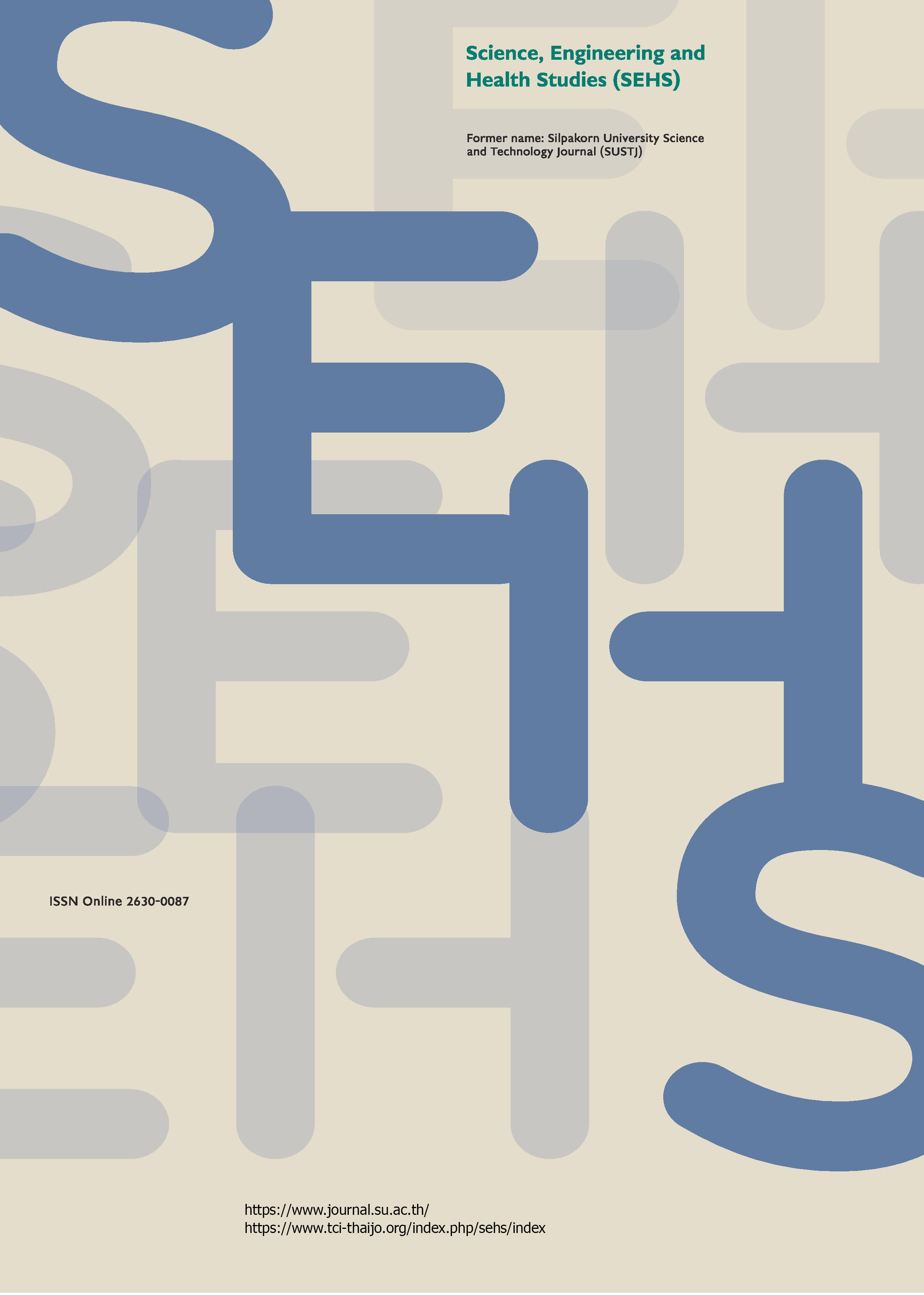In vitro antioxidant and anticancer activities of Clinacanthus nutans extracts
Main Article Content
Abstract
Clinacanthus nutans (CN), from the Acanthaceae family is a medicinal plant widely used in Thailand and Malaysia. CN is commonly used as a treatment of inflammation, cancer, and herpes virus infection. This study aimed to determine the antioxidant activity and anticancer properties of CN leaves extracts on human colorectal cancer cell lines, HCT 116 and HT-29. In this study, CN leaves powders were extracted in methanol, chloroform, and acetone at different durations. The crude extracts were assessed for total phenolic content (TPC), total flavonoid contents (TFC), 2,2-diphenyl-1-picrylhydrazyl (DPPH) radical scavenging activity and MTT (3-(4,5-dimethylthiazol-2-yl)-2,5-diphenyltetrazolium bromide) tetrazolium reduction assay. The extract using acetone showed with the highest TPC. The highest total flavonoid content was the methanol extract. The DPPH radical scavenging activity, IC50 of methanol extract was 19.67 µg/mL and exhibited the most efficacious antioxidant property among the others. The 24-hour methanol extract showed the most promising results on MTT assay. Therefore, CN methanol extract is a promising candidate to proceed in other anticancer studies such as cell cycle arrest and apoptosis assays.
Downloads
Article Details

This work is licensed under a Creative Commons Attribution-NonCommercial-NoDerivatives 4.0 International License.
References
Azizah, A. M., Hashimah, B., Nirmal, K., Siti Zubaidah, A. R., Puteri, N. A., Nabihah, A., Sukumaran, R., Balqis, B., Nadia, S. M. R., Sharifah, S. S. S., Rahayu, O., Nur Alham, O., and Azlina, A. A. (2019). Malaysia National Cancer Registry Report 2012-2016. Putrajaya, Malaysia: National Cancer Registry, pp. 1-116.
Baba, S. A., and Malik, S. A. (2015). Determination of total phenolic and flavonoid content, antimicrobial and antioxidant activity of a root extract of Arisaema jacquemontii Blume. Journal of Taibah University for Science, 9(4), 449-454.
Bhardwaj, M., Cho, H., Paul, J. S., Jakhar, R., Khan, I., Lee, S. J., Kim, B. Y., Krishnan, M., Khaket, T. P., Lee, H. G., and Kang, S. C. (2018). Vitexin induces apoptosis by suppressing autophagy in multi-drug resistant colorectal cancer cells. Oncotarget, 9(3), 3278-3291.
Chan, K. W., Khong, N. M., Iqbal, S., and Ismail, M. (2012). Simulated gastrointestinal pH condition improves antioxidant properties of wheat and rice flours. International Journal of Molecular Sciences, 13(6), 7496-7507.
Cutsem, E. V., Lenz, H. J., Kohne, C. H., Heinemann, V., Tejpar, S., Melezínek, I., and Ciardiello, F. (2015). Fluorouracil, leucovorin, and irinotecan plus cetuximab treatment and RAS mutations in colorectal cancer. Journal of Clinical Oncology, 33(7), 692-700.
Galanakis, C. M., Goulas, V., Tsakona, S., Manganaris, G. A., and Gekas, V. (2013). A knowledge base for the recovery of natural phenols with different solvents. International Journal of Food Properties, 16(2), 382-396.
Herald, T. J., Gadgil, P., and Tilley, M. (2012). High-throughput micro plate assays for screening flavonoid content and DPPH-scavenging activity in sorghum bran and flour. Journal of the Science of Food and Agriculture, 92(11), 2326-2331.
Ksouri, R., Megdiche, W., Debez, A., Falle, H., Grignin, C., and Abdelly, C. (2007). Salinity effects of polyphenol content and antioxidant activities in leaves of the halophyte Cakile maritimai. Plant Physiology and Biochemistry, 45(3-4), 244-249.
Nickavar, B., Kamalinejad, M., and Izadpanah, H. (2007). In vitro free radical scavenging activity of five Salvia species. Pakistan Journal of Pharmaceutical Sciences, 20(4), 291-294.
Quah, S. Y., Chin, J. H., Akowuah, G. A., Khalivulla, S. I., Yeong, S. W., and Sabu, M. C. (2017). Cytotoxicity and cytochrome P450 inhibitory activities of Clinacanthus nutans. Drug Metabolism and Personalized Therapy, 32(1), 59-65.
Rawla, P., Sunkara, T., and Barsouk, A. (2019). Epidemiology of colorectal cancer: Incidence, mortality, survival, and risk factors. Przegla̜d Gastroenterologiczny, 14(2), 1-15.
Schaffer, M., Schaffer, P. M., and Bar-Sela, G. (2015). An update on Curcuma as a functional food in the control of cancer and inflammation. Current Opinion in Clinical Nutrition and Metabolic Care, 18(6), 605-611.
Sengul, M., Yildiz, H., Gungor, N., Cetin, B., Eser, Z., and Ercisli, S. (2009). Total phenolic content, antioxidant, and antimicrobial activities of some medicinal plants. Pakistan Journal of Pharmaceutical Sciences, 22(1), 102-106.
Sheikh, B. Y., Sarker, M. M. R., Kamarudin, M. N. A., and Mohan, G. (2017a). Antiproliferative and apoptosis inducing effects of citral via p53 and ROS-induced mitochondrial-mediated apoptosis in human colorectal HCT116 and HT29 cell lines. Biomedicine and Pharmacotherapy, 96, 834-846.
Sheikh, B. Y., Sarker, M. M. R., Kamarudin, M. N. A., and Ismail, A. (2017b). Prophetic medicine as potential functional food elements in the intervention of cancer: a review. Biomedicine and Pharmacotherapy, 95, 614-648.
Stone, V., Johnston, H., and Schins, R. P. (2009). Development of in vitro systems for nanotoxicology: methodological considerations. Critical Reviews in Toxicology, 39(7), 613-626.
Thangaraj, K., Balasubramanian, B., Park, S., Natesan, K., Liu W., and Manju, V. (2019). Orientin induces G0/G1 cell cycle arrest and mitochondria mediated intrinsic apoptosis in human colorectal carcinoma HT29 Cells. Biomolecules, 9(9), 418.
Tungmunnithum, D., Thongboonyou, A., Pholboon, A., and Yangsabai, A. (2018). Flavonoids and other phenolic compounds from medicinal plants for pharmaceutical and medical aspects: An overview. Medicines, 5(3), 93.
Wang, K. S., Chan, C. K., Hidayat, A. F. A., Wong, Y. H., and Kadir, H. A. (2019). Clinacanthus nutans induced reactive oxygen species-dependent apoptosis and autophagy in HCT116 human colorectal cancer cells. Pharmacognosy Magazine, 15(60), 87.
WHO. (2019). Cancer. World Health Organization. [Online URL: https://www.who.int/news-room/fact-sheets/detail/cancer] accessed on November 22, 2020.
Yong, Y. K., Tan, J. J., Teh, S. S., Mah, S. H., Ee, G. C. L., Chiong, H. S., and Ahmad, Z. (2013). Clinacanthus nutans extracts are antioxidant with antiproliferative effect on cultured human cancer cell lines. Evidence-Based Complementary and Alternative Medicine, 2013, 462751.
Zlotogorski, A., Dayan, A., Dayan, D., Chaushu, G., Salo, T., and Vered, M. (2013). Nutraceuticals as new treatment approaches for oral cancer–I: curcumin. Oral Oncology, 49(3), 187-191.
Zulkipli, I. N., Rajabalaya, R., Idris, A., Sulaiman, N. A., and David, S. R. (2017). Clinacanthus nutans: a review on ethnomedicinal uses, chemical constituents and pharmacological properties. Pharmaceutical biology, 55(1), 1093-1113.


